




It's simple: Good starts with you.
Not because of who you know, the kind of car you drive or your social calendar. It’s not in your strength, skill or status—the kind of accomplishments you’d place on your resume.
Good starts with you because God created you. He called you good. You bear his image. You’re loved simply because you’re you.
That kind of love prompts action. And there’s a you-shaped hole in this Fight for Good.
You’re not just here, you’re here to live out a story only you can. So, if you’re one of the hopefuls, come roll up your sleeves with us. In days filled with chaos and pain, we serve the hurting and helpless.
You can be the reason somebody believes in goodness. You can make an impact right where you are.
By Douglas Riley, Commissioner



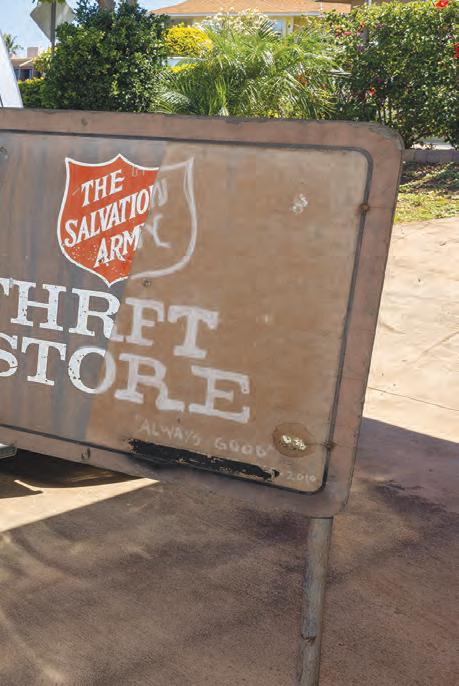


Buhl
30840 Hawthorne Boulevard
Rancho Palos Verdes, CA 90275
General Information: 562/436-7000
COMMISSIONER DOUGLAS RILEY Territorial Commander
CHRISTIN THIEME, Editor-in-Chief and Literary Secretary
HILLARY JACKSON, Managing Editor
KAREN GLEASON, Senior Editor
HALEY OSNESS, Editor
CORY GAUDAUR, Digital Operations Director
EMILY ANDERSON, Social Media Editor
KEVIN DOBRUCK, Art Director STAFF Published by
COLONEL EDDIE VINCENT Chief Secretary Find evidence of The Salvation Army’s impact and ways you can do good right where you are at caringmagazine.org caringmagazine.org
Envoy Kevin Nagasaki continues to minister following the 2023 Maui wildfires that destroyed the city of Lahaina including The Salvation Army Lighthouse Corps and thrift store. See story on page 14.
BY JOHN DOCTER
GOD’S GRACE ISN’T TIED TO OUR ACTIONS OR OUR SENSE OF FAIRNESS. IT FLOWS FREELY FROM A PLACE OF PURE LOVE, WITHOUT CONDITIONS OR PREREQUISITES.
BY DOUGLAS RILEY, COMMISSIONER
My garage is where everything gets tossed—tools, old boxes, unused sports gear and random knickknacks. As time goes on, the clutter builds, and what started as a simple storage space turns into a chaotic mess. The door can barely open, and finding anything useful becomes a challenge. It’s easy to imagine just closing the door and avoiding the mess altogether.
Can you relate?
But what if someone offered to help? Not just a little bit, but to really dive in—to sort through the chaos, organize everything, and help reclaim the space?
How incredible would that feel?
That’s exactly what God’s grace does for us. When our lives are messy, full of clutter, confusion, and things we’d rather forget, God doesn’t turn away. Instead, he steps in, rolls up his sleeves, and helps us sort through it all.
The beauty of grace is that it’s unearned, unmerited and undeserved. Yet, even when we deserve condemnation and rejection, God extends his unrelenting grace every single day. He also invites us to join this lifestyle of grace, even toward those who deeply harm us.
Are you ready to be fiercely gracious?
It’s easy to be gracious when everything is in order, when the garage is tidy, and there’s no visible mess. But grace becomes challenging when we’re confronted with other people’s faults—or when our own shortcomings become too hard to ignore. We need grace most when we least deserve it.
Andy Stanley, in his book “The Grace of God,” describes grace as the love we don’t deserve yet somehow receive—the gift that feels too good to be true.
Living in a society that prizes individual rights and justice, it’s easy to fall into the trap of thinking that grace is something we can earn or deserve through good deeds. Yet, God’s grace isn’t tied to our actions
or our sense of fairness. It flows freely from a place of pure love, without conditions or prerequisites.
Grace is often the first casualty in organized religion. As we build systems and structures, we sometimes lose sight of the very essence of our faith. We rationalize our behavior, justify our lack of compassion and make excuses for not extending grace to others. But grace doesn’t operate on our terms—it is as constant and unwavering as God’s love.
John 1:14 reminds us, “The Word became flesh and made His dwelling among us. We have seen His glory, the glory of the one and only Son, who came from the Father, full of grace and truth.” Jesus was the embodiment of grace, walking among us to show us what true grace looks like.
It’s true life can feel just as messy as my garage— cluttered with past regrets, unresolved conflicts and hidden fears. But God wades into our mess, offering us grace to help clean up, restore and renew.
“It is through the grace of God that we are saved, just as they are” (Acts 15:11). This message of salvation by grace alone, through faith alone, in Christ alone, is at the heart of our mission as Christians.
May we carry this message of grace into every interaction, every relationship and every corner of our lives. As we go about our days, let’s extend the same grace we’ve received to a world that desperately needs it. And may we remember: We might not deserve it, but God’s grace is always there, willing to help us clean up, restore and renew.
Let’s be fiercely gracious. | C |
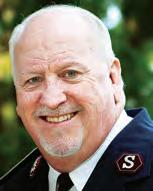
Commissioner Douglas Riley is the Territorial Commander of The Salvation Army Western Territory.
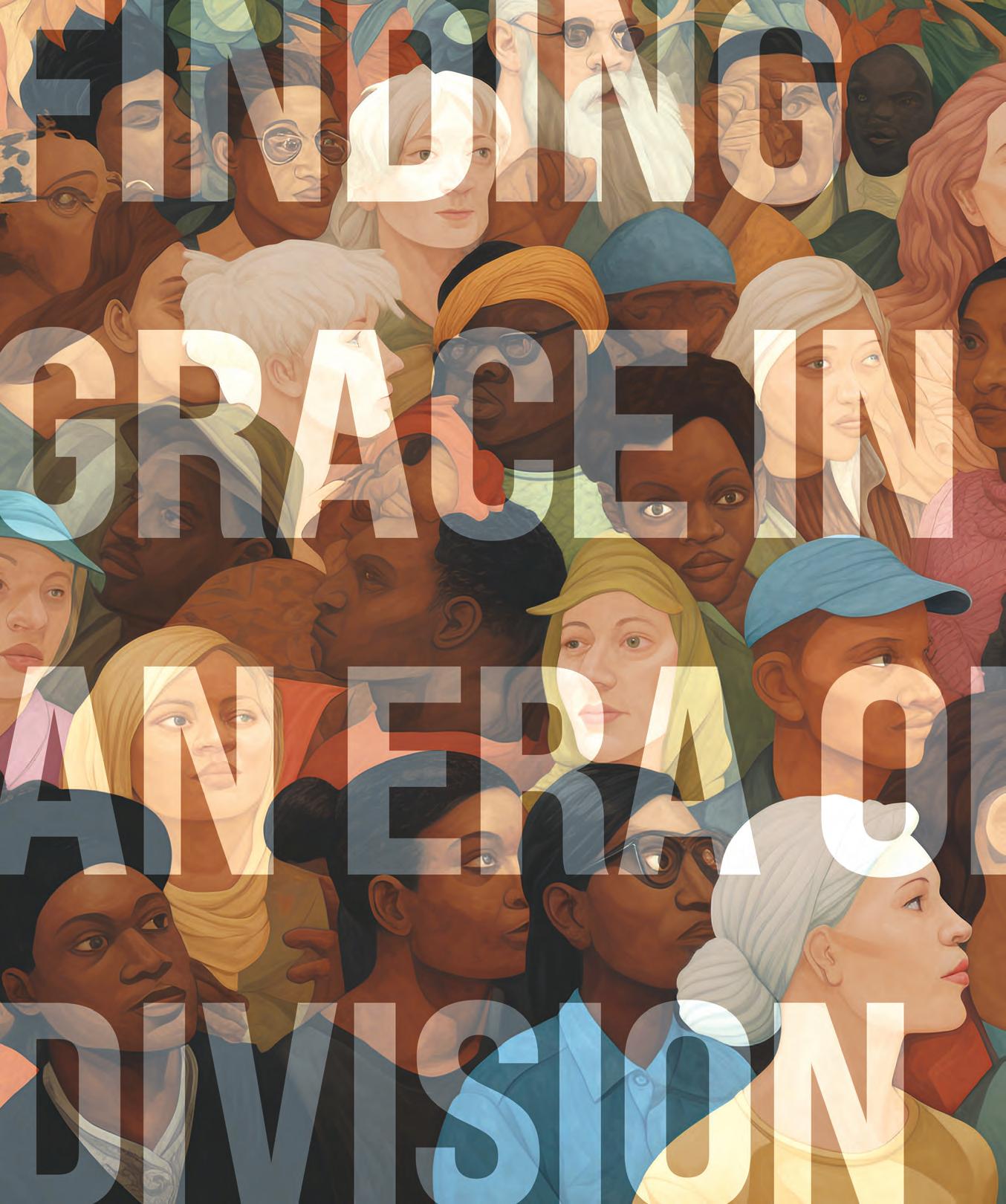

A 25-year reflection with bestselling author Philip Yancey
What is so amazing about grace?
That’s the question author Philip Yancey started with when he wrote the book by that title, “What’s So Amazing About Grace,” published in 1997. It went on to sell over 2 million copies.
And now, 25 years later, Yancey released a revised version—updated for the modern day.
As the author of 13 Gold Medallion Award-winning books and two ECPA Book of the Year awards, including for “What’s So Amazing About Grace,” Yancey will tell you some things never change.
As he writes, “Grace is the church’s great distinctive. It’s the one thing the world cannot duplicate, and the one thing it craves above all else—for only grace can bring hope and transformation to a jaded world.”
What does it look like in action?
Grace does not excuse sin, he says, but it treasures the sinner. True grace is shocking, scandalous. It shakes our conventions with its insistence on getting close to sinners and touching them with mercy and hope.
How can Christians contend graciously with moral issues that threaten all they hold dear?
And how can we become living answers to a world that desperately wants to know, What’s So Amazing About Grace? And could use a whole lot more of it.
Following is an excerpt from The Do Gooders Podcast Episode 171: What’s So Amazing About Grace? with host Christin Thieme and Philip Yancey. Hear the full interview wherever you listen to podcasts or at caringmagazine.org/podcast.
Christin Thieme: After 25 years, you’ve re-released “What’s So Amazing About Grace?” What was your original goal with it?
Philip Yancey: I had started asking people, in an airplane seat next to me or in a doctor’s office waiting room, I say, “I’m a writer. I’m writing a book, and I’m writing about Christians, especially evangelical Christians. When I say that word, evangelical Christian, what comes to your mind?” And not one time did they say, “Those
I THINK DOWN DEEP WE’RE ALL THIRSTING FOR GRACE. “

Author Philip Yancey
YOU DON’T LEARN GRACE BY BEING AROUND PEOPLE WHO ARE JUST LIKE YOU. YOU ONLY LEARN GRACE BY BEING AROUND PEOPLE WHO CHALLENGE YOU. “

Read “What’s So Amazing About Grace?” (Zondervan, 2023) by Philip Yancey.
are the servant people. Those are the really extraordinarily nice people. Those are the grace-filled people.”
They would say things, “Well, they’re hypocrites. They’re holier than thou. They’re trying to get me to do things I don’t want to do.” They just had this image of Christians as these killjoys who are messing up their lives or looking down on them. And I thought, “Boy, that is so different than what I read in the gospels about the way Jesus conducted himself.” … So somehow, we’re not conveying that welcoming spirit that Jesus did to people in real need. And I wanted to find out why not, and what would it take to restore that aura of grace around Jesus followers.
And you’ve said that this book has sold more copies and provoked more responses than anything else in your writing career. Why do you think this topic in particular touched such a nerve with people?
I think, down deep, we’re all thirsting for grace. Grace is the one thing that gets us past. Like family feuds, I know about those. I have a small family, they’re just three of us. And two, my mother and brother, hadn’t spoken in over 50 years. I finally got them on the phone together after 50 years, shortly before my mother died.
But watching that, and I’ve read things like one in six people in the United States have stopped all association with a family member or a close friend because of a disagreement over politics. We’re seeing that more and more. Even something like the pandemic, instead of coming together, we divided. Mask, not mask, vaccines, no vaccines. Those kinds of issues. They would split churches, they would split families.
And how do you get past that? Well, the only way I know to get past it is through grace, and it starts with a realization of God’s grace for us, God’s forgiveness of us. And then, we are supposed to take that same spirit and show the rest of the world that these barriers that we erect can be dismantled.
Just to clarify, what is grace?
It’s a hard thing to define. My most fun encounter with the word grace was I was returning a car out where you live, in Los Angeles. And I was an hour late because of the LA traffic, right?
Yes, welcome.
Yeah, right. And then, I show up at the airport...I’m already kind of frustrated and upset because I figured they’re going
to charge me a whole extra day because I’m one hour late. And instead, the woman behind the counter said, “OK. That’s it, Mr. Yancey.” I said, “Well, don’t I owe you anything else?” “No.” “Well, I’m late.” She said, “Yeah, but we have a grace period.” And I said, “Well, what is that? What’s grace?” And she thought for a minute, I don’t think they covered that in the Hertz training manual, and she said, “Well, I don’t know. But I guess it means that even though you’re supposed to pay, you don’t have to.”
And I thought, “That’s a pretty good start, isn’t it?” Grace is a free gift of God. It’s just the realization that God already loves us. There’s nothing we could do to try to get God to love us, he already does. It’s just a matter of holding out our hands and receiving the free gift of God’s love and forgiveness. And a lot of people have trouble with that, we have trouble receiving things. We want to earn our way. We want to be independent, pull ourselves up by our own bootstraps. And that doesn’t work. You can’t try to be more spiritual so that God will like you. Often, when you do that, you miss grace entirely.
What do you think we’re missing about grace today?
The main thing we’re missing is that we hang around people who are just like us. We tend to gravitate toward people who think like us, who are same education background, same race. Think of the book clubs you go to or the church you go to. If I visited your church, there’s a good chance they would look a lot like you. And I understand that, we’re tribal people and that makes sense. However, that’s not how you learn grace. You don’t learn grace by being around people who are just like you. You only learn grace by being around people who challenge you.
Maybe challenge you because of their lifestyle. Maybe they are offensive to you, morally offensive, and you think what they’re doing is wrong. Okay? You’re allowed to think that. But you’re not allowed to say, “So therefore, I won’t have anything to do with those people.” That is not the way to grow in grace. The way to grow in grace is to sit down with them, to serve them, to befriend them, to try to understand life from their point of view, their perspective. And I think that’s what we’re missing.
So, how do we rectify that?
You do that by serving. I happened to be in New York City just one week after 9/11. And I contacted The Salvation
Army and they escorted me down. And I saw these people just working day and night, serving people they’ve never met, would never see again. But you are an Army of service and in ministry to prisons, in ministry to people who are suffering from addiction, those kinds of things. You don’t say, “OK. For me to help you, you’ve got to be more like me, so you’ve got to sign this statement saying you agree with me.” No, you’re there to serve people in need, and that was the Jesus style.
Before he left the last night with his disciples, he said, “Let me show you what you’re supposed to be doing once I’m gone.” And he washed their feet, this demeaning task, saying, “You’re not here to rule. You’re here to serve.” And when you do that, grace will cross those boundaries that we build up.
What is one practical way somebody today could start to embody more grace in their own life and extend it to others?
I would say deliberately choose people that you know are going to be challenging to you. Maybe start with somebody in your family, some cranky uncle who makes racist comments or something like that. And start by saying, “OK. I think we probably disagree on this issue of race, but I’m not sure. And I’d like to have a discussion with you just to understand your point of view. This isn’t an argument. I’m not going to...Unless you want. I don’t want to tell you what I believe, I would just really like to understand you. I wonder if you could explain that to me and let me try to reflect it back to see if I understand it correctly.”
It’s amazing how just that start in the conversation, I’m taking argument off the table, nobody’s going to win or lose, but I just really want to understand you. And you’re honoring the person. And it’s just a way to start that initial conversation. I do that almost instinctively as a journalist because I’m trying to get people to talk. And if I go in with abrasive questions, then they clam up or they don’t really give me anything good in return. But if I come in saying, “I really want to understand your perspective so that I can present it to my readers.” If I have that spirit, I’m much more likely to get helpful responses. | C |
HEAR THE FULL INTERVIEW with Philip Yancey on The Do Gooders Podcast Episode 171: What’s So Amazing About Grace? Find it wherever you listen to podcasts or at caringmagazine.org/podcast.



BY BILLIE LAWSON
Growing up in a household marred by addiction and abuse, I often felt like I was drowning in darkness. Yet, through the grace of God and the compassionate outreach of The Salvation Army, I found a glimmer of hope that eventually transformed my life.
My childhood was filled with challenges no child should ever endure. Raised in a family of nine, my siblings and I faced unimaginable hardships due to our parents’ struggles with addiction. As the youngest, I bore the brunt of abuse in its various forms, leaving scars that would linger for years to come.
Hear Billie Lawson share her story in The Do Gooders Podcast Episode 166: An answered Christmas prayer that changed a life. Find it wherever you listen to podcasts or at caringmagazine. org/podcast.
Fast forward to 1986, as a mother of three and the spouse of a U.S. Marine, I grappled with the harsh realities of financial instability. Despite my husband’s tireless work ethic, we struggled to make ends meet, especially during the holiday season when the pressure to provide for our children weighed heavily on my shoulders.
For me, Christmas approached like an ominous cloud, casting a shadow. Memories of my own childhood Christmases, devoid of joy and abundance, haunted me. I felt like a failure as a mother, overwhelmed by the inability to fulfill my children’s expectations.
In desperation, I turned to prayer, a concept I had only grasped in its simplest form. With tear-stained cheeks, I poured out my heart to a God I scarcely knew, pleading for guidance and solace in the face of adversity. Little did I know my prayers would soon be answered.
The very next day, someone from The Salvation Army walked into the 7-Eleven where I worked and asked if I knew anyone who needed a Christmas tree. I humbly admitted I did and she gave me a slip of paper with an address on it. When I arrived there, I received not only a tree for my family but toys and even food for that Christmas.
Through The Salvation Army’s outreach, I experienced firsthand the power of unconditional love and support, igniting a new sense of hope within me.
As the holiday unfolded, infused with simplicity and gratitude, I realized true joy transcends material possessions. The gifts we received were not just tangible items but symbols of God’s unwavering presence in our lives, a reminder that he hears our prayers and answers them in unexpected ways.
My journey with The Salvation Army did not end with that Christmas miracle; it was only the beginning of a transformative chapter in my life. Years later, I found myself drawn to the organization, compelled to pay forward the compassion and support that had once been extended to me.
I joined The Salvation Army as an employee and started a journey of healing and redemption. Surrounded by mentors and colleagues who exemplified the organization’s ethos of service and compassion, I found solace in ministering to others facing similar struggles.
Through The Salvation Army’s many outreach programs, I witnessed firsthand the impact of small acts of kindness on individuals and families in need. Each interaction served as a reminder of God’s boundless love and the transformative power of faith.
Today, as I reflect on where I’ve been and where I am now, I’m filled with gratitude for The Salvation Army and the role it has played in shaping my life. What began as a moment of despair has blossomed into a life of faith, purpose and service.
My message to those facing hardship is simple: Never give up hope. In moments of darkness, turn to prayer and trust that God’s grace will guide you through. And if you find yourself needing support, reach out to organizations like The Salvation Army, where love and compassion await with open arms.
As I continue my journey with The Salvation Army, I am reminded of Jesus’ words in Matthew 25:40: “I say to you, whatever you did for one of these least brothers of mine, you did for me.”
We all have the power to touch lives, uplift spirits and spread God’s love to those in need. So let us embrace a spirit of love, compassion and giving each day. And may we never forget that in serving others, we are serving God himself.
I echo the sentiments of a Salvation Army officer, whose words continue to resonate with me: “Worry about nothing and pray about everything.”
On this journey, we are never alone. | C |

“
THROUGH THE SALVATION ARMY’S OUTREACH, I EXPERIENCED FIRSTHAND THE POWER OF UNCONDITIONAL LOVE AND SUPPORT, IGNITING A NEW SENSE OF HOPE WITHIN ME. — Billie Lawson
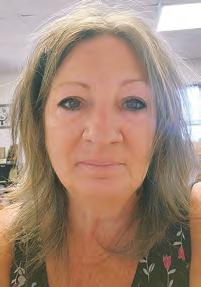
BY HILLARY JACKSON • PHOTOS BY JOHN DOCTER
Inside Envoy Kevin Nagasaki’s garage is a Salvation Army thrift store sign. It’s seen better days. The elements have worn off half the design, and someone—Nagasaki suspects a local artist—has outlined where the letters should be, only they’ve omitted the “i.” Probably by mistake.
This might seem like an odd thing to hold on to, but it’s the only remaining part of The Salvation Army Lahaina Lighthouse Corps that burned Aug. 8, 2023, along with historic Lahaina town in the deadliest U.S. wildfire in more than a century.
Nagasaki said that morning started out fairly normal—he went to the food bank, came back, unloaded the van and got word a fire had started in the area. He said he drove to the fire, and when he got there, it had been put out. Later in the afternoon, he heard another fire had started, and that it was moving down the hill.
“It was gusty…70-80-90 miles-an-hour winds coming down…And then, all of a sudden, it hit the town,” he said. “Within 15-20 minutes, it was one street away from us.”
At first, he tried to protect the property with a garden hose. The corps complex contained not only spaces for worship, social services and the thrift store, but Nagasaki’s home he shared with his wife, Vidella Nagasaki, as ministry leaders in the community for nearly 30 years.
It became apparent they needed to leave. They loaded up his truck with everyone who was around—people experiencing homelessness, members of the corps.

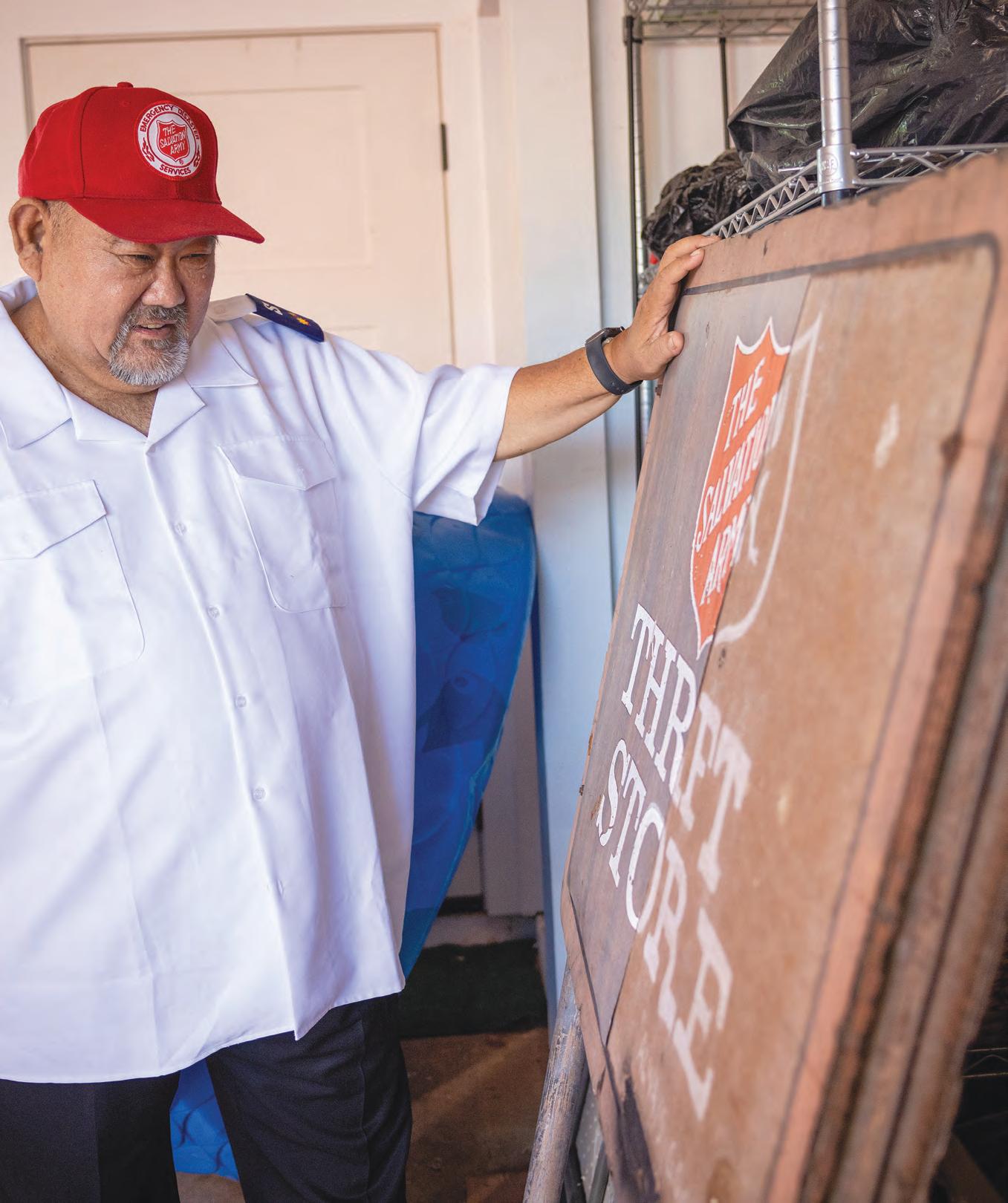


GOING TO THE DIFFERENT SITES THAT WERE OPEN, IT MADE A DIFFERENCE BECAUSE
PEOPLE WERE SEEING ME…AND THEY KNEW THAT WE WERE ALIVE, THAT WE SURVIVED. IT WAS GOOD TO SEE A LOT OF DIFFERENT PEOPLE.
— Envoy Kevin Nagasaki
Vidella grabbed their pets—a dog and a cat. Frightened, the cat escaped her grasp and ran away. They had to keep going.
When he pulled away from the corps with a car full and traveled to a safe point at the top of Shaw Street that day, Nagasaki said he knew everything at the property would be lost. The corps building and his home were already on fire.
“I let it go when I left the driveway that day,” he said.
From the top of the Lahaina Bypass, he said the group looked down onto the town, and it was “just a big cloud of dark smoke.”
He called Salvation Army Kahului Corps Officer Captain Steve Howard and told him: “The corps is gone.”
“What are you talking about?” Howard said from the other side of the island—he’d seen the advisories for wind, but thought it would likely amount to power outages or a small brush fire. He met Nagasaki and the group from Lahaina when they arrived in Kahului.
“I didn’t sleep that night, because I really was thinking, ‘What’s the next move here? What is the next thing we’re gonna have to do?’” Nagasaki said.
The next day, Howard represented The Salvation Army at the Emergency Command Center and The Salvation Army began handling the coordination of meals.
“We went from grieving the loss of the Lahaina Corps and all that was going on…but the next morning, we got to work,” he said.
The Salvation Army served as the primary feeding organization for the immediate relief phase of the emergency/disaster response, coordinating more than 800,000 meals and making some 120,000 more.
Howard said he’d call Nagasaki and the Lahaina Corps staff, who made many of the deliveries across the sites offering shelter. He’d say, “Get 800 meals to the War Memorial shelter,” and they’d go.
The Salvation Army served as the primary feeding organization for the immediate relief phase of the emergency/disaster response —coordinating more than 800,000 meals and making some 120,000 more—after the deadliest U.S. wildfire in more than a century burned Maui’s historic town of Lahaina.
I’VE GOT TO STAY HERE AND HELP MY COMMUNITY, I’VE GOT TO MĀLAMA MY COMMUNITY. AND I FEEL LIKE THE SALVATION ARMY HAS PROBABLY BEEN THE WIND UNDER MY HELPING-HAND WINGS. —Rita Lei Medina
I

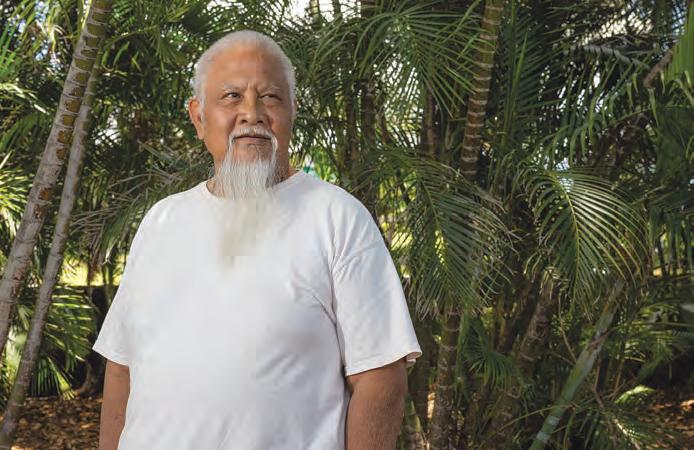
“Going to the different sites that were open, it made a difference because people were seeing me…and they knew that we were alive, that we survived,” Nagasaki said. “It was good to see a lot of different people.”
Eventually, Howard said The Salvation Army partnered with Hopper, a local company similar to Uber Eats, to make the deliveries. Howard said this freed up the team to help in other ways, like providing emotional and spiritual care at the Disaster Resource Center.
“When one thing got figured out, it was on to the next and on to the next, and whatever the community needed from us, we were there to supply within the resources we had to give,” Howard said.
In the immediate aftermath of the fires, some 8,000 Lahaina residents were living in hotels—Nagasaki among them. While he said he was thankful for a safe place to sleep and shower, he knew the challenges.
“I do understand what other people went through,” he said. “OK, today, you stayed at this hotel. OK, this week, you’re gonna have to pack up your stuff, and we’re moving you to another hotel in another part of the island. Oh, and by the way, in two weeks, we’re going to move you again to another place. Oh, and by the way, you have 72 hours to
move, but no, I’m going to move you in 12.’ It was difficult.”
People began to transition out of hotels, many after securing longer-term housing with FEMA and insurance assistance. The Salvation Army purchased a home that Nagasaki now resides in as he works to re-establish the organization’s physical presence in West Maui.
As of March 27, roughly eight months after the fire, Hawaii Governor Josh Green said in a press conference some 3,000 people were still living in hotels—and he expected them to be out by July 1.
For James Sahagon, the Westin Maui Resort and Spa in Ka’anapali was home for almost seven months before he was relocated to the nearby Hyatt on April 18. He shares the room with his dog.
“If you’re on vacation it’s nice,” he said. “After a while, it gets to close in on you. Even though you have a nice bed, TV, you get fed…You cannot beat home.”
Prior to the fire, Sahagon said he was staying at a shed as part of a work-trade agreement. For people like him, who weren’t homeowners, and therefore not entitled to certain forms of assistance, the path has been less straightforward— especially if they want to remain in West Maui, where there was already a housing shortage before the fire.
Sahagon said he doesn’t know what’s next.
“I leave it in God’s hands,” he said.

As efforts continue to help people transition from hotels to longer-term housing situations, The Salvation Army has come alongside in a new way: the Transition Assistance Program.
Howard said when households transition out of a hotel, they are referred to The Salvation Army by the American Red Cross to sign up for the program, which offers gift cards for $200 per family member to Walmart, Foodland or Shell.
“That’s basically just to help them as they transition out of the hotel to get groceries, to get whatever supplies they might need,” Howard said. “Pretty much everything was taken care of for them, and now they’re going into a house, so they need those things.”
Inside the Kahului Corps, Rita Lei Medina sits behind a glass window, directing people to various social services while she fills out forms for a family’s transition assistance.
Medina worked nearly 13 years for the Lahaina Lighthouse Corps before, as she said, she lost her home and her job all in one day.
People have offered for her to come stay with them elsewhere, she said. She tells them: I’m not going anywhere.
“I’ve got to stay here and help my community, I’ve got to mālama my community. And I feel like The Salvation Army has probably been the wind under my helping-hand wings,”
As efforts continue to help people transition from hotels to longer-term housing situations, The Salvation Army has come alongside in a new way: the Transition Assistance Program.
she said. “Being able to continue to help my community has been the chicken soup for my soul. And it’s probably one of the things that’s kept me going.”
In the immediate aftermath of the fires, Medina lived in a hotel and eventually secured a new place to live and bought a vehicle. Before, her whole life was walkable in the heart of town.
When people come for assistance and share what they went through, she said it helps put the puzzle pieces together.
“Western Maui is very tight knit. Everybody knows everybody,” she said. “When I run into people, especially folks that are coming for assistance, I’m like, ‘Oh my gosh, auntie, it’s so good to see you again,’ and it just warms my heart…Coming in communication with one another, being able to help one another, being able to pray with one another, that’s very healing as well.”
Hawaiian and Pacific Islands Divisional Commander Major Troy Trimmer said he’s continuing to hear stories from Aug. 8.
“The reality is that all of Hawaii is impacted,” he said, noting losses ranging from the life of loved ones to property and belongings.

“All of our employees, all of our volunteers, advisory board members, advisory council members, donors in this division are probably more richly impacted as a result of this disaster than any disaster I’ve ever been engaged with,” he said. “There’s an incredible resolve. That’s not just the Hawaii way. It’s not just Maui Strong. It’s not just Lahaina Strong. There’s a resolve that a faithful God will sustain and will hold them and will walk them through this.”
Nagasaki has deep ties to the Lahaina community. It comes with having served in one place for years, and having a familial connection to the place—it’s where his grandparents and his mother were from.
It’s impossible to travel West Maui for any period of time without him being stopped for a conversation or given the shaka sign from a rolled-down window.
“They always ask, ‘How are you doing?’ I try not to ask that question anymore, because, I mean, I already know how they’re doing,” he said. “I’d rather open up with another question, and it helps them to open up and talk about what’s going on, how are they feeling…And a lot of people have learned that they’re not alone.”
He said he’ll ask things like: “Have you seen this person?” or “Have you spoken to her?”
Driving into Lahaina, white crosses line the Lahaina Bypass, adorned with photos, flowers and ribbons to remember the 101 lives lost in the fires.
“Basically, we knew all of them,” Nagasaki said.
While he said he’s witnessed some healing, the grief is complex.
“Everybody grieves different,” he said. “This community is strong…I think that in time, the healing will happen, but it’s just going to take time, and everybody processes differently.”
About four weeks following the fire, Nagasaki got a call from his
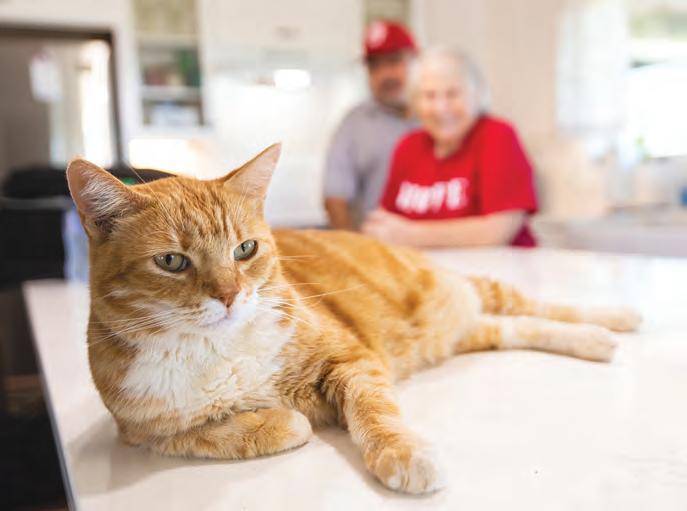
grandson. The Humane Society had found their cat—in Kahului.
“That’s only God,” he said.
Despite presently not having a corps building, Nagasaki said many of the elements of ministry haven’t changed. He estimates prior to the fires, more than 90 percent of Lahaina Lighthouse Corps attendees experienced homelessness.
He regularly ministers to them at the beach, where many people live. With buses currently running at no charge, many congregants join the worship at the Kahului Corps.
His mantra? “Build bigger and better,” though there are lots of unknowns about the future, like location—the new Lahaina Lighthouse Corps will take a different location out of respect for the restoration of Moku‘ula, a Native Hawaiian historic and cultural landmark near the site of the former corps.
“It’s going to be different, definitely different,” he said. “But the spirit and the mission of The Salvation Army is still going to be out there to meet the need, no matter what.”
In the interim, Nagasaki said they’re trying to get more social services up and running, using a food trailer, office trailer and shower trailer, maybe even holding movie nights in his garage.
For Charles Camara, the Lahaina Lighthouse Corps was a special place. He said he’s been attending since 2009.
“They’ve always had their doors open, no matter how beat up you was or how much God you had in you,” he said.
It’s where he’s been encouraged in his recovery from addiction. It’s where his babies were dedicated.
“My little girl cried for the church,” he said.
She asked him, “When are they going to make the Lighthouse again?”
“I tell her: the lighthouse is in you,” he said. “Wherever you go… you have to shine the love you have, the same love God gave you.” | C |
1 PETER 4:8
The Salvation Army annually helps nearly 24 million Americans overcome poverty, substance abuse and economic hardship through a range of social services. By providing food, emergency disaster relief, rehabilitation, clothing and shelter, The Salvation Army is meeting human needs without discrimination at 6,914 centers of operation across the country.
We help those in need 365 days a year.
And last year? Some 1,423,701 people dedicated their time and energy to volunteering alongside The Salvation Army.
Together, we …
The Salvation Army provided emergency shelter and transitional housing for 8,067,161 people.
The Salvation Army provided 155,968,200 meals through food boxes and hot meals.
The Salvation Army provided rent and utility assistance to 3,143,382 families in need.
Gifts to The Salvation Army help your neighbors navigate food insecurity, unexpected job loss, eviction concerns and devastating natural disasters. While dollars can be quantified, the power of your love cannot.
caringmagazine.org/give
Source: The Salvation Army 2023 Annual Report
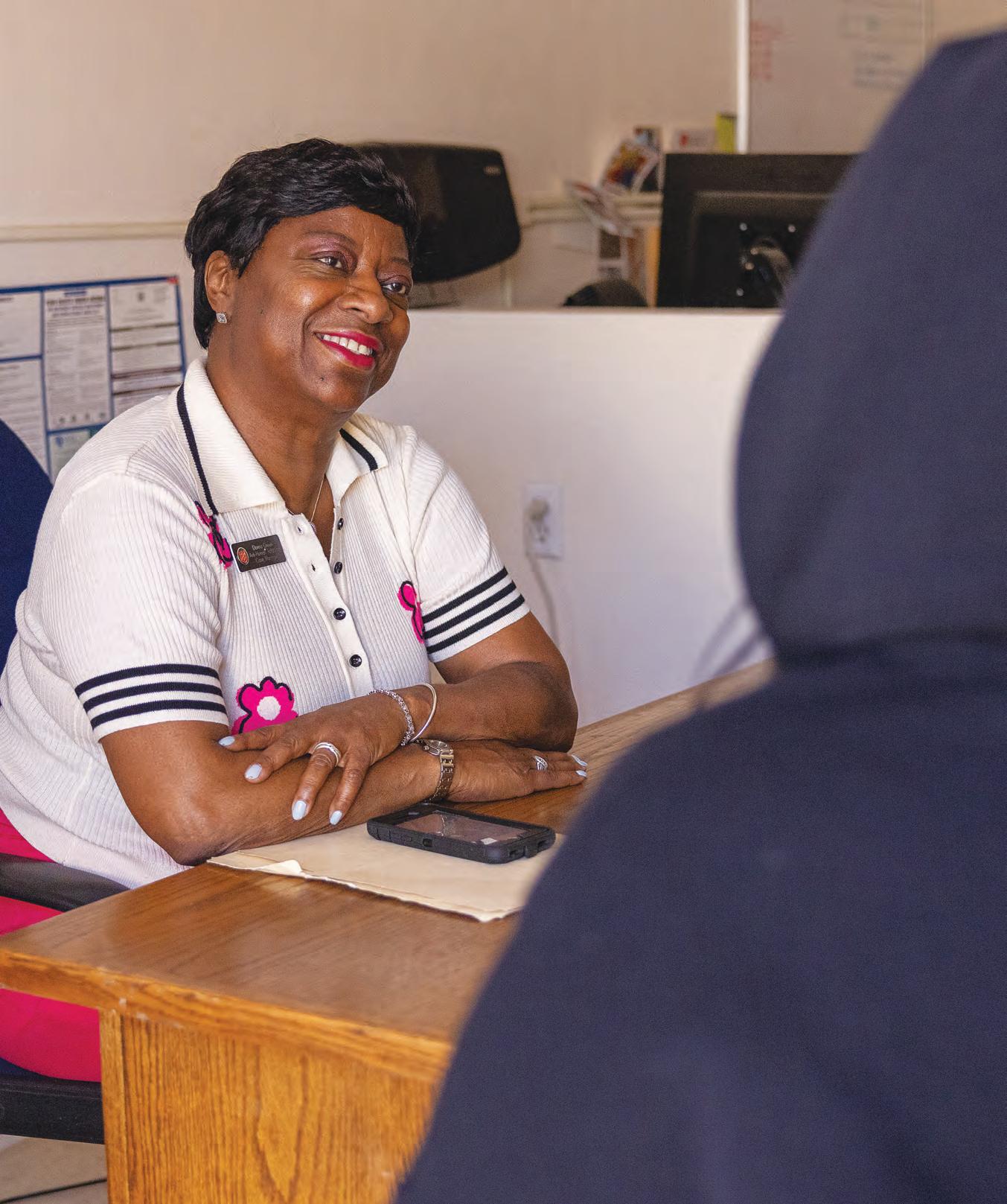
ALL OF THE SERVICES THAT THEY GET, I’VE USED THEM, AND I USED THEM AS A STEPPING STONE TO MOVE FORWARD. AND THIS IS WHAT I TRY TO TEACH THEM: DON’T GET STUCK HERE. THIS IS A STEPPING STONE TO MOVE FORWARD.
Donna Green
The Salvation Army SEEDS of Hope program reaches survivors of human trafficking in Las Vegas—and helped Desirae rebuild her life.
fter escaping a relationship with a man who became her trafficker, Desirae* called the National Human Trafficking Hotline.
She was referred to The Salvation Army SEEDS of Hope program in Las Vegas—one of The Salvation Army’s 13 anti-trafficking programs in the Western U.S. that offer wraparound services and trauma-informed care, often in life-threatening situations.
“I was in a dark place and didn’t know where I would wind up being,” she said. “I was having altercations with my mom because of my lifestyle. I had just finished school and there was a lot going on in my life. I just needed to escape from the way I was living.”
There, in October 2021, Donna Green became her case manager and the pair worked together for her healing.
Desirae also received mental health therapy and participated in trauma-informed groups.
“I learned that I am very capable of doing anything I set my mind on. I realized that I am resourceful, and I have a very good support system,” she said. She returned to school and graduated in May 2022 with an associate’s degree in health care administration, and secured a full-time job.
And that’s exactly the goal, Green said—self-sufficiency.
“I attended her graduation, and I was hollering,”
Green said. “She really did make me proud. And these are the things I look forward to when I come to work… That’s more fulfilling than any money in the world. To see somebody come from nothing and create something.”
Human trafficking is big business—an estimated $150 billion industry involving nearly 50 million people around the world, according to the International Labour Organization (ILO). Globally, The Salvation Army provides support to survivors through dedicated anti-human trafficking programs. Professionals like Green make it happen.
Here, she shares what it’s like to be on the frontlines of the fight against human trafficking.
Caring Magazine: What should people know about human trafficking that maybe they wouldn’t know?
Donna Green: They should know that it’s an issue. And it’s a big issue. Not only in Vegas—it’s happening everywhere… And another thing they need to know is that these people are human. They are people that we need to reach out to—and they can be saved, if we put in the effort to save them. And they don’t want much—most just want a place to lay their head so they can recuperate from what they’ve been through, three meals a day, some fresh clothes and a shower. You don’t realize how much that means to a person who’s been in the streets for months, maybe under the thumb of someone else.
Globally, The Salvation Army provides support to survivors through dedicated anti-human trafficking programs. In the Western U.S. alone, The Salvation Army served 183 trafficking survivors in 2023.

So I would say to people: Don’t discriminate and don’t judge because these are human beings.
Often survivors are referred to you by other agencies, the trafficking task force, the police or the website. Once they’re connected to the SEEDS of Hope program, what comes next?
Human trafficking is a $150 billion industry involving nearly 50 million people around the world, according to the International Labour Organization.
I do an assessment over the phone and then I bring them in…I have to really screen them to make sure that this is the appropriate program for them, and if they don’t need a higher level of care, and if so I’ll refer them out because there is a lot of mental health issues connected to trafficking. So I bring them in… single people, male, female, it doesn’t matter if they’re trafficked, and if we have space, we move them in that same day. If there is no space available, the client is referred to other agencies that offer similar services.
What are your major goals in case management?
The objective is to be able to be self-sustainable. Most people come in, and they don’t have proper identification. They don’t have any hope. They feel as though this is the only way they can live. And then most of the time the money that they make while being on the streets—the money from a nine to five can’t compare. So it’s being able to transition from one lifestyle to… being able to sustain without being sex trafficked, selling your body. Being able to have some self value, just gaining some hope that there’s a better way to do this. And that’s the hardest part, trying to let them see that they’re worthy. And they’re worth something. And it’s not a transaction. Your body shouldn’t be a transaction.
What is it like to have a front row seat to someone’s transformation?
It’s so rewarding… It’s the first job in my entire life that I look forward to coming to work. I look forward to seeing what’s going to happen today. I look forward to seeing the progression in the women. I love seeing them say, ‘Miss Green, I saved $1,000.’ ‘I got my license today.’ That is more rewarding than $100,000 for me. That inner peace I get just being able to serve. They see it and they know when you care. They know, and it makes them motivated to do something. And I also release my anonymity to some and let them know I didn’t always have two degrees. I wasn’t always this good person… So don’t beat yourself up.
I tell them when they come in to get busy, because time waits for no one. We’ve wasted a lot of time in the streets…Nobody owes you anything, right? And this is not a cash grab. Take advantage of all the services you’re getting right now because you’re going to need them in the long run. I also utilized the services of The Salvation Army, being a single parent, getting the toys. All of the services that they get, I’ve used them, and I used them as a stepping stone to move forward. And this is what I try to teach them: don’t get stuck here. This is a stepping stone to move forward. | C |
IF YOU OR SOMEONE YOU KNOW NEEDS HELP, the National Human Trafficking Hotline is confidential and available 24/7 with vital support and options to get help and stay safe. Call 1-888-373-7888.
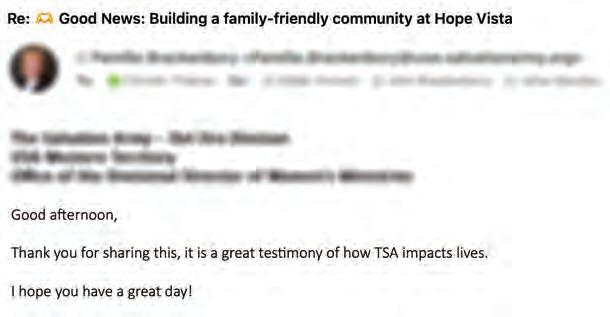

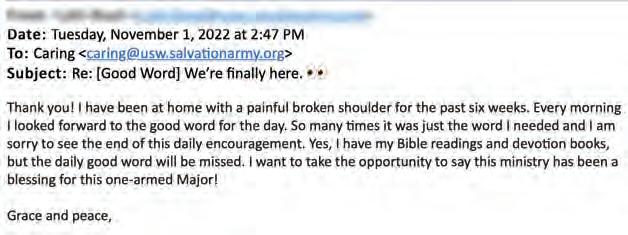


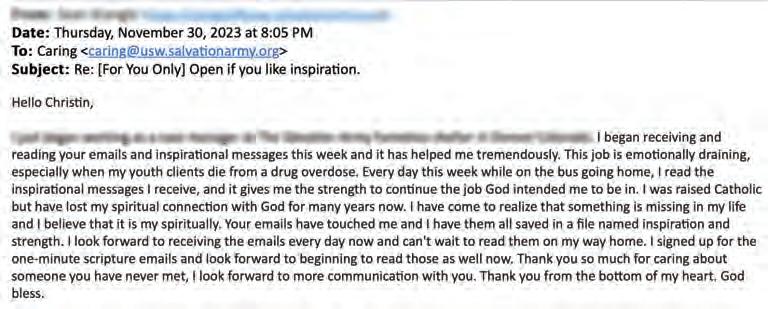
caringmagazine.org/subscribe

The Salvation Army’s efforts and reach position it as a source of care, guidance and support for youth, embodying a commitment to addressing diverse needs and overall well-being.
BY HALEY OSNESS
Isaiah Fuentes, a middle school student, raised his hand in a room at The Salvation Army Ray and Joan Kroc Corps Community Center in Coeur d’Alene, Idaho, to discuss the events of his day. He recalled the joy of sharing lunch with his friends as a high point but acknowledged feeling frustrated when he later disagreed with a teacher.
Seated in a room of nine of his peers, Fuentes is a part of something important: an after-school Mental Health Awareness Club (MAC) for middle schoolers. Hosted by licensed mental health counselor and Coeur d’Alene Kroc Center Youth and Family Support Specialist, Tyson Durbin, the club provides a supportive environment for preteens to navigate emotions and feelings.
Every Wednesday evening, the group starts by sharing the ups and downs of the day while Durbin walks them through any emotions or uneasy feelings.
Afterward, the club explores various topics such as stress coping, mindset management, self-awareness and identity development. Durbin develops the daily lessons and selects the discussion topics. He encourages students to take the lead in conversation and refers to it as a peer-led safe haven.
“Students are invited to dive into the world of mental health literacy and skill building through conversation and play,” he said.
Following discussions, students take a break to unwind in the gym or game room before participating in the concluding conversations. According to Durbin, getting active allows students to release excess emotional and social energy to help them process feelings.
After the initial weeks of the program in 2023, Durbin said the group of 10 advocated for it to continue long-term, emphasizing the current need to support youth mental health.
Between 2009 and 2019, persistent feelings of sadness and hopelessness, along with suicidal thoughts and behaviors among young people, increased by 40 percent, according to the Centers for Disease Control and Prevention (CDC) Youth Risk Behavior Surveillance System.
To draw national attention to the concerns, the U.S. Surgeon General issued an advisory in 2021 calling for public recognition and support for youth mental health.
“Ensuring healthy children and families will take an all-of-society effort, including policy, institutional, and individual changes in how we view and prioritize mental health,” U.S. Surgeon General Vivek Hallegere Murthy said in the advisory.
According to Durbin, that advisory sparked the Coeur d’Alene Kroc Center’s idea to implement an additional focus on community and youth mental health, resulting in his hiring in 2023 and the formation of the Mental Health Awareness Club.
And the club soon doubled in size.
“Mental health and suicide continue to be ongoing crises in Idaho,” Durbin said, noting that for the past five years, suicide has ranked as one of the leading causes of death among youth in the state.
According to a CDC report on Youth Mental Health, providing students with the space to explore mental health challenges at their own
AND FAMILIES WILL TAKE AN ALL-OF-SOCIETY EFFORT, INCLUDING POLICY, INSTITUTIONAL AND INDIVIDUAL CHANGES IN HOW WE VIEW AND PRIORITIZE MENTAL HEALTH.
— U.S. Surgeon General Vivek H. Murthy in a 2021 advisory calling for support for youth mental health
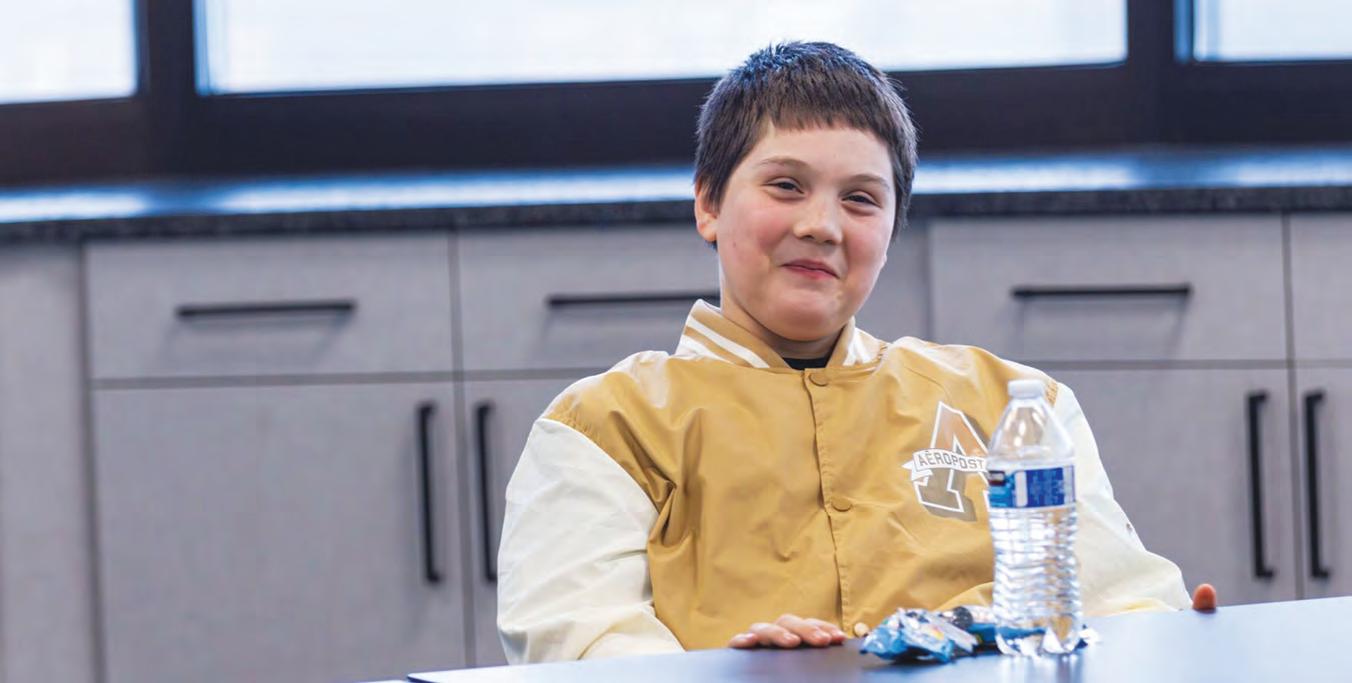
Middle school students discuss the best and most challenging parts of their day at club meetings, and learn coping tools for anxiety, anger or stress.
pace is the best approach to introducing youth to complex topics and diminishing concerns of suicide and failing mental health.
“Children are the leaders of the next generation,” Durbin said. “They carry an important message for us adults—to understand and support them.”
Durbin emphasized that when safety, trust and reliability are present, students find an environment that fosters improved mental well-being, which sets the foundation for thriving mental health.
He has seen progress firsthand. After teaching a lesson on stress-coping tools one week, he received feedback from a student who applied his advice of “stopping to think and breathe” to manage stress following a low grade on a test.
“I help to introduce and instill coping tools that students can utilize when they experience anxiety, anger or stress,” Durbin said.
His expertise as a trained healthcare professional helps him
The Salvation Army Ray and Joan Kroc Corps Community Center in Coeur d’Alene, Idaho, is one of 26 Kroc Centers across the U.S., made possible by a $1.5 billion gift from Joan Kroc, that provide children and families opportunities to discover and develop their passions and talents within their own neighborhood.
recognize signs of mental health struggles—things like lowering grades, anxiety or withdrawing from peers—and employ the best approaches to address them.
“All behaviors are messages,” Durbin said. “I just try to understand the message they’re sending to develop strategies of what’s next to help.”
As the need for greater support for youth mental health continues to be recognized across the U.S., The Salvation Army’s 400 after-school programs across the nation position the organization as a community hub for addressing the well-being of youth.
These safe spaces offer youth a place to go, unpack and feel connected, Durbin said.
“It’s important to look at the whole picture,” Durbin said. “The Salvation Army can support the mental health of individuals because we have a foundation to address the mind, body and spirit.” | C |
Persistent feelings of sadness and hopelessness, along with suicidal thoughts and behaviors, increased 40 percent among young people from 2009-2019, according to the Centers for Disease Control and Prevention Youth Risk Behavior Surveillance System.
BY HILLARY JACKSON
What if research for strategies to address homelessness was provided in a real-time feedback loop? What if it could happen in the heart of a shelter environment?
A program at The Salvation Army Center of Hope in Anaheim, California, says it’s possible. The Center for Applied Research and Innovation (CARI) aims to identify large-scale solutions to homelessness and other social challenges through social science research and program design.
It has met the moment.
In Orange County, where the Center of Hope is located, a poll from the University of California Irvine School of Social Ecology found more than 70 percent of residents described homelessness as “a very serious problem” alongside the amount of affordable housing.
The County is the third largest in California, a state that holds nearly 30 percent of the nation’s total population of unhoused people, according to reports compiled by the U.S. Department of Housing and Urban Development.
While HUD’s biannual point-in-time reports reflect a positive change— more people were housed in Orange County in 2022 compared to 2019—
data, and public opinion, shows there is more to be done.
“The Salvation Army has a mission to lead the nonprofit world in social science innovation, responding to the extraordinary challenges of society today, like homelessness,” said Managing Director Dr. Ben Hurst. “I think CARI is important because it helps keep The Salvation Army on the forward foot running towards the fight of these great challenges instead of being reactionary to the problems all around us. It puts the energy in the innovation space that is really critical in the day in which we live.”
CARI rests on The Salvation Army’s 14-acre, comprehensive Center of Hope campus alongside a 325-bed emergency homeless shelter, Pathways supportive housing apartments and the Adult Rehabilitation Center (ARC). The goal of the campus? Life transformation, said Divisional Secretary for Orange County Major Ken Perine.
“We’re not about housing people for the sake of housing them,” he said. “The goal is forward movement in life and at the position where they can thrive.”
CARI is a part of that. Presently, CARI runs out of a portable unit as construction crews bring the vision for the Cen-
The Salvation Army Center for Applied Research and Innovation (CARI)—based at the Center of Hope in Anaheim, California—aims to identify large-scale solutions to homelessness and other social challenges through social science research and program design.
ter of Hope to life. Inside is a blue neon sign illuminating the phrase “Think Revolutionary.” And that’s Hurst’s goal—to ideate “high-impact solutions.”
“The big picture goal is for CARI to be a large-scale solutions center that is a collaborative hub of some of The Salvation Army’s best thinkers and problem solvers along with great solutions experts outside the Army,” Hurst said, “coming together and researching, designing and ultimately implementing enterprise-level solutions to these huge problems, like homelessness.”
CARI is the brainchild of Hurst, who completed a doctoral degree in Social Work from the University of Southern California in 2023. There, his dissertation focused on chronic homelessness and the Life Transformation Program, a

“
THE SALVATION ARMY HAS A MISSION TO LEAD THE NONPROFIT WORLD IN SOCIAL SCIENCE INNOVATION, RESPONDING TO THE EXTRAORDINARY CHALLENGES OF SOCIETY TODAY, LIKE HOMELESSNESS. —Dr. Ben Hurst
key component of an approach he calls the Homeless Throughput System.
Hurst likens the Homeless Throughput System to a baseball diamond, with each step representing a different phase of an individual’s journey from homelessness to self-sufficiency. At the pitcher’s mound is CARI, considering outputs for each individual. A homerun? Individuals who are not just housed, but drug-free, back to work and reintegrated into society.
At the first base: Emergency shelter, when people come from the streets to The Salvation Army’s shelter and receive trauma-informed care and case management. Once they have reached stabilization, they move to the second base: the Life Transformation Program, which focuses on recovery from addiction and other wraparound services.
“The early research and early data point to a breakthrough homeless response,” Hurst said.
Third base: Housing, both in the 72-unit Pathways supportive housing apartments on the Center of Hope Campus and locally.
“We don’t look at people as victims,” said Perine. “We look at people as just a few steps from victory, meaning they’re just a few steps from getting to
Recovery from addiction and wrap-around services
Pathways supportive housing apartments and more
where they need to be, which changes the whole dynamic.”
From research to action
Shannon Lamb has worked for more than 12 years in The Salvation Army’s homelessness programs in Orange County and is currently the Director of Quality Assurance for homeless service programs and a CARI researcher.
“I’m a very boots-on-the-ground details person and Dr. Ben is the major visionary,” she said. “We work really well together.”
She said Hurst leads a majority of the macro research, which filters down when they meet as a team to decide what to focus on. Lamb said she digs into the programmatic research, considering questions like: How do we make this happen? What do we need? What is it going to cost us? How does it fit with our mission?
One way CARI research has been used is by identifying what Hurst called a statistically small but significantly un-
Trauma-informed care and case management
REINTEGRATED INTO SOCIETY
Housed, drug free and back to work
derserved population of unhoused Native Americans in Orange County. He said CARI designed a program response from scratch and achieved county funding for it: the Eagleman Project.
Through a grant from Equity in OC (EiOC), an Orange County Health Care Agency initiative, The Salvation Army served as the lead organization for the Eagleman Project, working with Native and other organizations with the goal to provide temporary or permanent housing for 50 Native American/Alaskan Natives experiencing homelessness or at risk of homelessness in Orange County by April 2024.
“We did have to switch our aim a little bit,” said Lamb. “We started with reaching out to those who were homeless and found that the need was actually much greater for families that were facing eviction… It wasn’t something we were aware of.”
Project lead Frank Luna said the project then met its housing goal, and began needed larger conversations about
recognition—the tribes indigenous to Orange County are state recognized instead of federally recognized, something he said impacts items like scholarships and funding that are typically exclusive to federally recognized tribes.
“There’s a lack of resources for the people that are actually indigenous to Orange County,” said Luna, a descendant from one of the tribes in Orange County. “This project opened up the doors so that they got equal access to resources. It’s just not to those that are from federally recognized tribes, so that was a really special part of the project.”
Luna said the Eagleman Project held four community events, and has reached over 250 people in Orange County and the surrounding areas, through workshops, community forums and Community Action labs, with some meetings held at Salvation Army facilities. Additionally, he said an advisory committee attends city council meetings in what he called “American Indian hotspots” to speak during the public
WE DON’T LOOK AT PEOPLE AS VICTIMS. WE LOOK AT PEOPLE AS JUST A FEW STEPS FROM VICTORY, MEANING THEY’RE JUST A FEW STEPS FROM GETTING TO WHERE THEY NEED TO BE, WHICH CHANGES THE WHOLE DYNAMIC. —Major Ken Perine
comment section to raise awareness.
“The overall goal was to really create that visibility, and maybe be the linchpin for the system change,” he said.
A history of innovation
For CARI, success is measured through creating dated research that leads to new programs, like the Eagleman Project, Hurst said.
“I think success is measured in effectively producing research and data that influences conversations in these critical spaces, as well as producing new innovative programs that The Salvation Army can replicate to address these critical issues,” he said. “Data and research will be helpful… but they need to lead to something ultimately.”
That’s why location is key.
“Synthesizing the data and research that’s done into actionable programs that The Salvation Army can deploy in the field rapidly—that’s the goal,” he said. “It’s situated on the 14-acre Center of Hope campus on purpose, so that it has real-time feedback immediately from the field, and some of the sharpest insight into what’s working and what’s not working.”
The idea for a Salvation Army research branch is expressed as far back as in Salvation Army Founder William Booth’s 1890 book, “In Darkest England,” which shared the concept of an “Intelligence Department” among Booth’s list of social reforms needed for people experiencing poverty in Victorian England.
“Power, it has been said, belongs to the best informed, and if we are effectually to deal with the forces of social evil, we must have ready at our fingers’ ends the accumulated experience and information of the whole world on this subject,” Booth wrote. “The collection of facts and the systematic record of them would be invaluable, rendering the result of the experiments of previous generations available for the information of our own.”
Since Booth’s writings from The Salvation Army’s early days, research has been integrated to inform the organization’s social services offerings. In Scotland, The Salvation Army and the University of Stirling established The Salvation Army Centre for Addiction Services and Research to further research on addictions and interventions in 2017. In the U.S., The Salvation Army partnered with Indiana University Lilly Family School of Philanthropy to provide fresh key data about poverty and need in the U.S. through the Human Needs Index.
benchmark, but it tells you a lot that when you have a big vision, and a bold vision, how people will step up and make big and bold gifts,” he said, noting that within the first year of fundraising, multiple $1 million gifts came in from donors who hadn’t given to The Salvation Army previously.
California holds nearly 30 percent of the nation’s total population of unhoused people, according to reports compiled by the U.S. Department of Housing and Urban Development.
Among them, the Samueli family, the namesake of CARI’s Samueli Applied Research Hub. At the groundbreaking ceremony for the Center of Hope Jan. 31, 2022, the family presented The Salvation Army with a ceremonial $1 million check from the Samueli Foundation.
We have a lot of momentum…more than I think we’ve ever had,” Coleman said, noting The Salvation Army had raised almost 90 percent of the funds needed to build the physical home of CARI at the time of publication, and has its eyes set on an endowment campaign to sustain the research center.
CARI has caught the attention of the community, too. Orange County Area Command Director of Development Justin Coleman said before CARI, The Salvation Army in Orange County had not received a $1 million gift, despite the fact the county is often ranked among the wealthiest in the nation.
“We don’t want to use that as a
After all, the social challenges CARI focuses on are considered “wicked problems”—challenges with breadths hard to understand, and ever-evolving presentation in communities, Hurst said. He noted homelessness is a prime example, with many facets that solutions often respond only to one aspect of.
“Finding solutions is very difficult,” he said. “We have to keep innovating to come up with really extraordinary answers.” | C |
As prices rise, The Salvation Army is partnering with schools to fight food insecurity for students and families.
BY CHRISTIN THIEME
The United States Department of Agriculture (USDA) published its forecast for 2024 food prices, predicting the year would see a 1.6 percent increase for “food-at-home” prices—the food purchased from a grocery store or supermarket.
That’s welcome news following an average annual increase of 5.95 percent since 2020, including the spike in prices by 11.4 percent in 2022.
It’s not just inflation that’s driving prices up, according to the U.S. Government Accountability Office. Supply chain disruptions related to the pandemic and other factors from drought to an outbreak of avian influenza and the war in Ukraine, one of the world’s largest wheat exporters, have had a direct impact on our grocery bills.
And that impact is even more critical considering 10 percent of households in the U.S. were already struggling with food insecurity, meaning limited or uncertain access to adequate food, according to the USDA.
Alongside rising prices, a new report from the USDA found hunger in the U.S. rose sharply in 2022.
Some 44.2 million people lived in households that had difficulty getting enough food to feed everyone in 2022, up from 33.8 million people the year prior, according to the report. Those families include more than 13 million children experiencing food insecurity, a jump of nearly 45 percent from 2021.
Then in April 2024, The Urban Institute, a nonprofit research organization, reported food insecurity increased for the second straight year in 2023.
“For 2020-2021, food insecurity was largely flat overall, reflecting a robust private and public response to the pandemic,” said Dr. Elaine Waxman, senior fellow in the Income and Benefits Policy Center at the Urban Institute and one of the report’s authors. “We saw a huge outpouring of charitable assistance but also things like stimulus checks, enhancements to SNAP and an enhanced child tax credit— even universal school meals—which all made a big impact. Then as those emergency allotments were removed, there was less aid available at the same time of increased pressure from food inflation.”
And that combination squeezed family food budgets.

“Even though other indicators of the economy are mostly positive [GDP, unemployment, consumer spending], we’re continuing to see rising food insecurity,” Waxman said, and as a consequence: “Charitable food continues to be a linchpin for a lot of people.”
The Urban Institute found use of charitable food in 2023 remained above prepandemic levels as one in six adults (16.6 percent) reported their households received charitable food.
It’s something The Salvation Army’s numbers confirm in more recent years, too. In the Western U.S.—spanning the 13 Western states, plus Guam, the Marshall Islands and Micronesia—the organization provided over 6 percent more meals in fiscal year 2023 than the prior year—more than 9 million meals in total. It also provided over 11 percent more grocery orders.
And snacks? Those also increased by more than 27 percent—an additional 815,000 snacks served.
So where are all those snacks going? In some cases, to local schools.
“Most of the schools we partner with say they need snacks—
Even though other indicators of the economy are mostly positive, we’re continuing to see rising food insecurity. Charitable food continues to be a linchpin for a lot of people. —Dr. Elaine Waxman
“
OUR BUYING POWER IS NOT AS GREAT AND AT THE SAME TIME EVERYTHING IS MORE
Sargent
granola bars, jello, apple sauce,” said Lisa Sargent, ministry leader in-charge at The Salvation Army Yakima (Washington) Corps. “Kids come to school still hungry.”
What started as a partnership between The Salvation Army in Yakima and one local school has expanded to include 16 schools across the county serving nearly 800 kids a month.
In some cases, the partnership means school staff have food on hand to give to students who are hungry at school. In others, administrators are sending backpacks filled with food home with students for the weekend.
“We’re meeting needs where families are—in schools,” Sargent said. “Even though we have a flexible food pantry here, it can be hard for families to get here. We realized we needed to reach out to schools.”
It’s part of an effort to reach those who might not know help exists. The Urban Institute found among adults whose households were food insecure in 2023 and did not receive
charitable food, just 42 percent were aware of local charitable food resources.
In the heart of central Washington, with surrounding agricultural production of apples, cherries and hops, Yakima has a median household income of $55,734. Just over 19 percent of its 97,000 residents live in poverty.
And as the nation’s food prices increased, The Salvation Army served 174 percent more people in Yakima (or 44,579 total people) in fiscal year 2023 than it did in 2020. Similarly, grocery orders provided jumped by 48 percent to 19,759 orders.
“Every food bank or pantry is struggling in Yakima,” Sargent said. “Our buying power is not as great and at the same time everything is more expensive for families—the cost of living, utilities, rent, food, everything is up.”
The school food security partnership once operated under a grant from the state of Washington, but after it wasn’t reissued, The Salvation Army has turned to donations. “We’re committed to continuing to serve,” Sargent said.

Food assistance from The Salvation Army Western Territory from October 2022 to September 2023: CATEGORY FY2023 YoY INCREASE
Provided 9,061,547 6.3 %
And one of the schools where Sargent noticed a need is Yakima Online High School and Open Doors, for grades 9-12 and ages 16-21, respectively. While these diploma or GED students work primarily online, they can come to the school to do their work. With a combined 750 students and just four portable classrooms, Principal Lois Menard said class is packed every day.
“I have students from all backgrounds. They are the most challenged students. They have the most barriers, in my opinion. All schools have that but here they’re concentrated,” said Menard, who has served as principal here for the past 14 years. “You know, you just know when they have that need. I talk to them privately when they’re bringing their students and ask if they would like a food bag. They are really grateful.”
When one mom recently said yes to an offer for food, Menard carried a bag out to her truck.
“She opened the truck to put the food in and there were two sleeping bags in the back,” Menard said. “It was clear they were living in there.”
She said she gives away about 20 bags of food a week.
“I know the poverty and the struggles in their homes. They might not have heat or money to get here. Many are parents themselves,” Menard said. “But these students are coming here by choice—they’ve made the decision that ‘I’m ready to do education again,’ and I always say when students are safe and they’re not hungry they’re going to learn better. It’s really important.
“I just love these kids, all these people. We’re all just humans,” Menard said. “When you’re kind to people, they’re kind back.”
Nearby at the corps, Sargent also oversees an after-school program that’s at capacity with 40 elementary school kids. Buses from the Yakima School District drop kids off right in front of the building.
Once a week, the program invites parents to eat dinner with their kids. But every day, the snacks are ready. | C |
11.3%
U.S. consumers spent an average of 11.3 percent of their disposable personal income on food in 2022 —divided nearly equally between food at home and food away from home (USDA).
25%
From 2019 to 2023, the all-food Consumer Price Index (CPI) rose by 25 percent (USDA).
45%
Some 44.2 million people lived in households that had difficulty getting enough food to feed everyone in 2022, up from 33.8 million people the year prior. Those families include more than 13 million children experiencing food insecurity, a jump of nearly 45 percent from 2021 (USDA).
155 million
The Salvation Army in Yakima, Washington, partners with 16 schools across the county to address hunger, serving nearly 800 kids a month. Nationwide, The Salvation Army served more than 155 million meals last year.


As
more and more disasters strike nationwide, coordinated
efforts to plan a strong response offer some solace.
BY KELLY DAWSON
IFthere were a single adjective to describe disasters of recent memory, it would likely be “unprecedented.”
Wildfires have sparked suddenly and quickly burned out of control, incinerating established towns. Hurricanes have formed with surprising speed and intensity, unabashedly appearing outside regimented seasons and locations. Rain, so much rain, has blanketed areas that are ill-equipped to handle such ferocious storms, leading to flooding and mudslides in steady succession.
And that’s without mentioning the consequences of when land has become too dry, or shook, or covered in
heavy snow. All of that has happened, too. It seems like more and more disasters are happening all at once.
According to the National Oceanic and Atmospheric Administration, 28 separate billion-dollar natural disasters occurred in the United States in 2023, a record that the chief scientist attributes to a changing climate. In nearly every weather event imaginable—heat, rain, storms, snow—a subsequent disaster occurred.
“One thing about disasters is that they don’t discriminate,” said Ian Anderson, Director of Emergency/ Disaster Services (EDS) and Service Extension in The Salvation Army’s Intermountain Division. “They can impact everyone and anyone.”
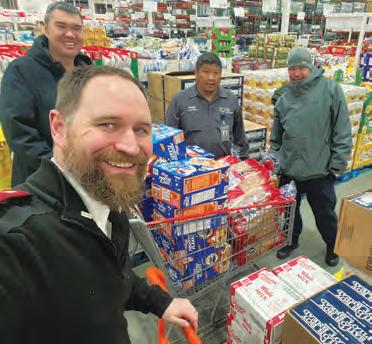
Jenni Ragland, the Emergency/Disaster Services Director for The Salvation Army Alaska Division, has seen a rise in the need for aid in remote parts of the state when the Alaskan winter hits hard.
Between Christmas and mid-February 2024, six Alaskan communities contacted The Salvation Army for help due to power outages and frozen water lines. In Koyukuk, temperatures dropped to 50 degrees below zero, disrupting the village’s water system.
The Salvation Army in Fairbanks, working with the Tanana Chiefs Conference and the Red Cross, coordinated four flights to Koyukuk to deliver nearly 10,000 bottles of water, food and other essentials. One of these flights also carried the equipment and personnel needed to fix the village’s water treatment facility.
“Thanks to coordinated efforts, we got support to the community within 48 hours,” Ragland said.
Beyond emergency assistance, The Salvation Army continues its support through programs like Operation Santa, which brings Christmas gifts to remote villages. In 2023, Operation Santa visited Golovin and Koyuk, communities affected by Typhoon Merbok in 2022, and Tuluksak and Ft. Yukon, which suffered spring flooding in 2023. These initiatives bring resources and hope to those enduring harsh winters.

In August 2023, when a dry wind blew across the island of Maui, it ignited somewhere in the mountainous brush and brought a worstcase scenario to the historic coastal town of Lahaina below. Smoke and flames killed dozens of people and engulfed nearly every structure, forcing some survivors to jump into the ocean for safety.
The wildfire became the worst natural disaster in Hawaii’s modern history, and yet another bullet point showcasing environmental extremes. But if there could be a foil to unprecedented disasters, perhaps it’s found in high levels of preparedness.
In the aftermath of devastation, a network of organizations swoop in to provide care—and given how regularly these disasters have occurred, knowing this safeguard exists can be its own form of solace in the future.
“There is a framework that we’ve been using for catastrophic events for decades,” said John Berglund, EDS Director for the Western U.S. “It continues to improve, but it is a well-oiled and time-tested machine.”
The Salvation Army is one of the most recognizable service organizations in the country, and when disaster strikes, Anderson said people expect it to respond. It does so by partnering with federal, state, local and community-based organizations to provide necessities from three meals a day and shelter to even linens on a new bed.
In Lahaina, Berglund said The Salvation Army was present for survivors on day one. It was tasked with mass-care feeding, in which a government contract allowed The Salvation Army to provide roughly a million meals, but its wide-ranging teams did much more than that.
“Picture a large community center, where one side of the room is lined with nonprofit agencies and the other has government agencies,” Berglund said. “Our presence in that center was to have oneon-ones with survivors to provide financial assistance, emotional
PICTURE A LARGE COMMUNITY CENTER, WHERE ONE SIDE OF THE ROOM IS LINED WITH NONPROFIT AGENCIES AND THE OTHER HAS GOVERNMENT AGENCIES. OUR PRESENCE IN THAT CENTER WAS TO HAVE ONE-ON-ONES WITH SURVIVORS TO PROVIDE FINANCIAL ASSISTANCE, EMOTIONAL AND SPIRITUAL CARE AND OTHER SERVICES OR REFERRALS FOR LONG-TERM RECOVERY. —John Berglund
and spiritual care and other services or referrals for long-term recovery. Almost everyone lost everything, including loved ones.”
This robust response to disasters is tested and built when one isn’t happening, of course, and The Salvation Army is planning for them when a nightmare of what-ifs seems impossible.
The safety net that’s formed is structured over countless conversations around who knows what and how best to address a problem—with which equipment, people, funds—and every potential scenario is tailored to the distinct threats posed in different regions of the country.
Anderson and Berglund noted how an emergency in Anchorage looks different from one in Phoenix, just as it would in Seattle versus Denver. The one detail that may connect every location, though, is how strong their preparedness response may be.
“We spend a lot of time working with various organizations to meet the needs of any one community, and the list can go on and on,” Anderson said. “We want to be able to work alongside them, but we don’t want to overlap or get in anyone’s way. This is in addition to how The Salvation Army addresses needs daily, such as supporting the most vulnerable members of communities. It’s a delicate balance.”
Berglund said the entire system relies on building relationships everywhere, from government agencies like FEMA and non-profits like the Red Cross, to faith and non-faith-based groups.
The Salvation Army also routinely trains volunteers and re-trains staff who may have gotten rusty without a disaster, and inspects equipment that’s stored for the occasion.
“You have to position yourself to have a seat at the table, because if you’re not at the table assisting with these types of decisions then you’re part of the meal—devoured,” Berglund said.
And yet, as much as Berglund and Anderson are confident in the soundness of their plans, knowing one can be deployed at a moment’s notice as it was in Hawaii, some details could use support. “With disasters happening so frequently now, donor fatigue is very real,” Anderson said. “So one big challenge we’re facing is how to be even better stewards with the money we receive.”
They agree an era prone to disasters requires a flexible and versatile response. And they always have one ready to go.
“The Salvation Army works almost like an accordion—we can pump it up or down,” Berglund said. “In a disaster, we can pull from all of the resources we have to address the needs of a specific incident at a particular time. We know how to fill that gap, and we know we can.” | C |

Nicole Kanne, the Emergency/Disaster Services Director for The Salvation Army Southwest Division, said soaring summer temperatures, especially in Phoenix, can be deadly. And last summer, 425 people in Maricopa County died from heat-related causes.
To mitigate the heat, The Salvation Army operates 11 cooling stations in Phoenix during Excessive Heat Warnings, when temperatures often exceed 110 degrees for days. They also dispatch a mobile unit to downtown Phoenix, providing relief to encampments of people experiencing homelessness.
“People are encouraged to stop in for A/C, bottled water, hygiene kits and snacks,” Kanne said. “Some of our locations are able to provide showers, laundry, daytime drop-in services and entertainment, and all are pet friendly.”
EDS volunteers provided spiritual and emotional care to over 1,400 people in summer 2023 while distributing thousands of essential items like water and sunscreen.

THEY GOT ME RIGHT IN. THEY’VE BEEN TREATING ME REALLY WELL, DOING WHAT THEY CAN FOR ME. —Desiree Carvalho “

How
The Salvation Army is helping unhoused older adults.
BY KAREN GLEASON
Desiree Carvalho never saw it coming.
“I’ve worked all my life,” she said. “It’s all new to me.” At 66, she’s experiencing homelessness for the first time. For now, she resides at The Salvation Army Haig and Isabel Berberian Shelter and Transitional Living Center in Modesto, California.
After 26 years of marriage, Carvalho and her husband divorced, and Carvalho said she was left with nothing. She worked parttime, and for a while she rented a room in a house with several other women. She said after several months, with no notice, she was told to leave. A friend told her about the Berberian Shelter.
“They got me right in,” she said. “They’ve been treating me really well, doing what they can for me.”
Nearly 1 in 4 unhoused individuals are over age 55, according to the National Alliance to End Homelessness (NAEH) annual Point-In-Time homeless count from January 2023. The NAEH estimates the number of unhoused older adults will almost triple by 2030, from 40,000 to 106,000 people.
It turns out Carvalho isn’t alone. In fact, she represents a growing trend among older adults: homelessness.
Nearly 1 in 4 unhoused individuals are over age 55, according to the National Alliance to End Homelessness (NAEH) annual Point-In-Time homeless count from January 2023.
“When we first started getting the data on homelessness back in the 1990s, it showed that older people were underrepresented among the homeless population,” said Steve Berg, NAEH Chief Policy Officer. “And everybody gave credit to Social Security as the reason for that. It's the one population that gets support from the government.”
And yet the Alliance estimates the number of unhoused older adults will almost triple by 2030, from 40,000 to 106,000.
Berg said the main problem is Social Security no longer provides older adults with the security it once did.
Over time, as the cost of living increased, Social Security didn’t put enough emphasis on how much people with lower incomes pay for housing, he said.
“They're paying a very high percentage of their income for housing,” Berg said. “And housing has gone up faster than other costs of living steadily for decades. I think it's gotten to the point where Social Security is no
longer an automatic safeguard against homelessness… The long-term trend is that rents for a modest apartment have gone up faster than the wages in a modest job,” he said. “So people can’t keep up.”
Berg noted social services are critical to helping older individuals facing homelessness.
“In many communities, there just aren’t sufficient programs and resources to deal with the rising number of homeless people,” he said. “And it’s important that the older people who are most likely to become homeless have access to these programs.”
In Modesto, Jim Stokes, Director of The Salvation Army Berberian Shelter, said he’s been talking about this trend for a while.
“The actual demographics of our shelter are largely both disabled folks and seniors,” Stokes said. “The issue is our broken systems. Housing is expensive and if your only income is SSI [Supplemental Security Income] and housing vouchers aren’t within reach, you end up at our shelter because SSI isn’t enough to cover rent. Disability payments aren’t usually enough to cover rent either.”
According to Berberian Shelter data, the average client age has steadily increased since 2019. As of March, 33 percent of Berberian guests are 55 or older.
If you can’t keep up under normal circumstances, any life crisis—as Carvalho experienced—can make it untenable to maintain your home.
According to the NAEH, those who first experience homelessness at age 50 and older typically have experienced a financial or health crisis, lost a loved one, or otherwise experienced a relationship breakdown with the income-earner, and/or experienced barriers to continued ability to work.
And to Berg’s point about social services, individuals facing a crisis may not know what resources are available. Shelters like the Berberian, where seniors can stay as long as they need to, are crucial.
“The face of homelessness has changed and includes more and more seniors,” said Major Darren Stratton, Corps Officer of The Salvation Army Modesto
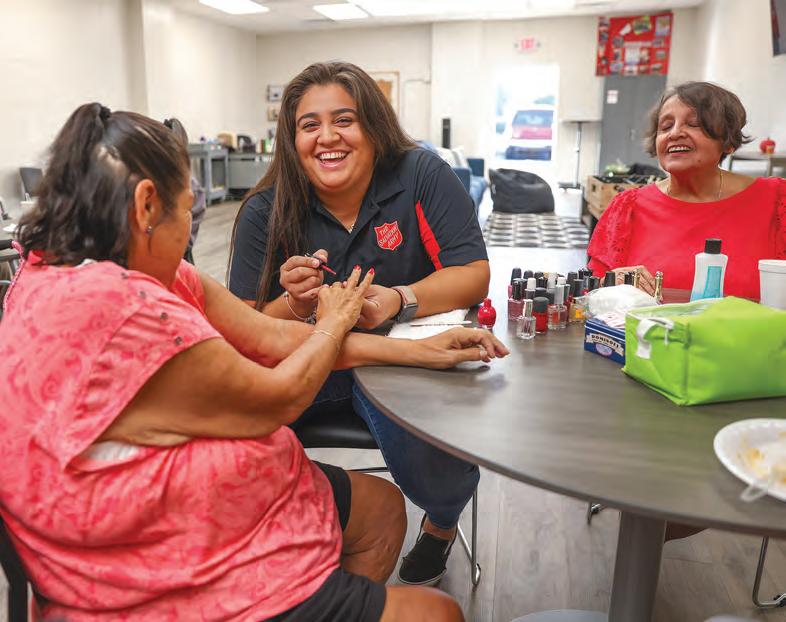
Corps and Red Shield Community Center. “The Modesto Salvation Army is working to identify ongoing funding sources for its sheltering operations—including services to our seniors—to ensure the Berberian Shelter continues to meet the needs of all guests entrusted to our care.”
In 2022, in addition to noting the rising age of guests at the Berberian Shelter, staff observed more seniors walking and stopping to rest near the Red Shield Center. Realizing the Modesto community lacked resources for its older residents, The Salvation Army worked to fill the gap.
With funding from Sutter Health, The Salvation Army opened a senior center at the Red Shield. The funds covered staffing, including a driver for an ADA-compliant vehicle and a cook who prepares breakfast and lunch for attendees. Stratton said that while people from the shelter attend the center, it is also open to the larger community. Recently, Sutter Health provided an additional two-year grant of $300,000 to continue the program.
Nearby, at the Berberian Shelter, Carvalho continues to work with her case manager to find permanent, affordable housing, but it’s challenging. The average monthly rent for an apartment in Modesto is currently $1,659 while the average Social Security benefit is $1,706 a month, per a report from Business Insider.
Meanwhile, she has a safe place to stay, for as long as she needs it.
“It’s a good experience,” she said. “I can go to my caseworker and talk to her. They’re very caring here.” | C |
Social Security is a program that provides financial support for Americans throughout their lives. It offers four main types of benefits: Retirement benefits, Social Security Disability Insurance (SSDI), Supplemental Security Income (SSI), and Benefits for spouses and other survivors of a family member who has died.
Social Security replaces a percentage of a worker’s pre-retirement income based on their lifetime earnings. In February 2023, the average Social Security retirement benefit was $1,782 per month.
SOURCE: Social Security Administration


BY LOU BUHL
PHOTOS BY JOHN DOCTER
“With hard work and perseverance anybody can change their circumstances,” said Sharira Thomas, vocational coordinator for The Salvation Army in Las Vegas. “Each day is a new day and you can start fresh and find a brand new beginning, just like I did.”
It might be the work, in fact, that helps people find stability after substance abuse, homelessness or incarceration—and that’s why The Salvation Army is investing in workforce development programs across the Western U.S.
According to the Substance Abuse and Mental Health Services Administration (SAMHSA), employment is linked with lower rates of relapse, improved self-esteem and reduced substance use and criminal activity.
Thomas found sobriety four years ago and now dedicates her efforts to helping others navigate the path to self-sufficiency with support from The Salvation Army.
Participants work through the Las Vegas
OUR ULTIMATE GOAL IS TO HELP PEOPLE FIND WORK AND WE DO THAT BY TRYING TO MEET THEM WHERE THEY ARE.
—Chef Timothy Tucker “

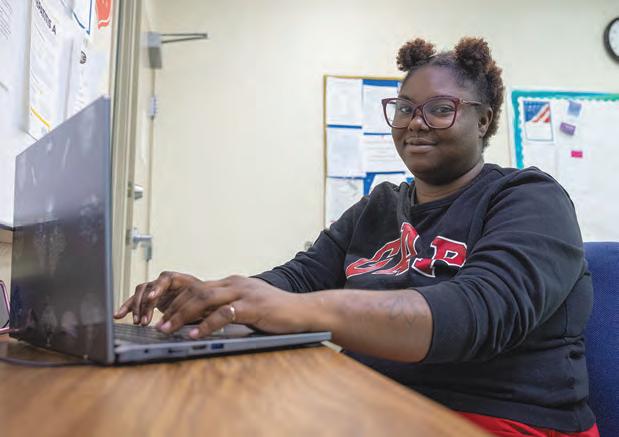
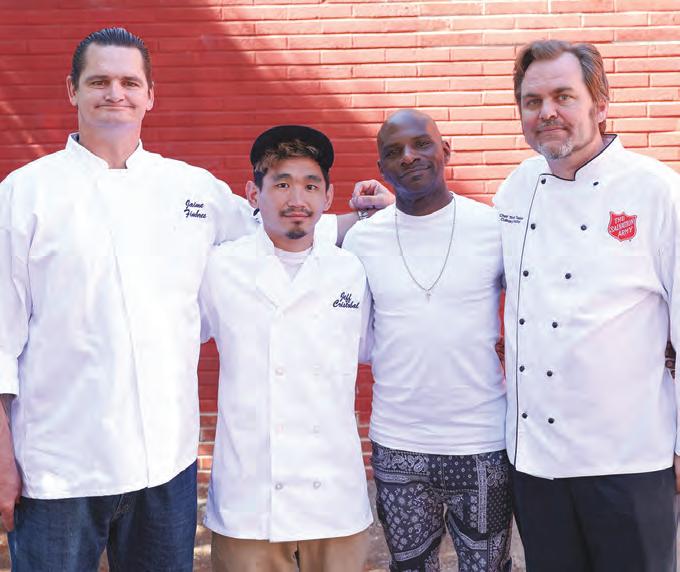
THERE’S ALL KINDS OF OPPORTUNITIES.
I’M JUST PUTTING ONE FOOT IN FRONT OF THE OTHER TO KEEP GOING FORWARD TO GET THERE. —Candice Huger “
vocational program to address potential barriers and find employment and independent living.
In 2022, the Vocational Program produced 71 graduates from training programs and 51 hires in direct job placement. The program also provided 3,950 job referrals and 2,140 interview sessions.
Thomas stressed the importance of the “Planning for Success” course, which equips participants with tools to “elevate their employability,” from career assessments to job counseling, pursuing further education and certifications.
“When you haven’t worked for a while because you’ve been in your addiction, it can become very discouraging,” Thomas said, emphasizing the crucial role of support during this transitional phase.
Participant Candice Huger said she has felt that support.
“I don’t know if I would be able to do this on my own,” Huger said. “I thought I would either end up dead or in prison.”
After experiencing domestic violence, struggling with substance abuse and facing criminal charges, Huger said she didn’t expect to survive let alone be in a place where she can help others.
“The Salvation Army saved my life and gave me another chance and a new outlook,” she said, noting she also went through the Las Vegas Adult Rehabilitation Center (ARC), one of The Salvation Army’s residential programs that provide spiritual, emotional and social assistance to individu-
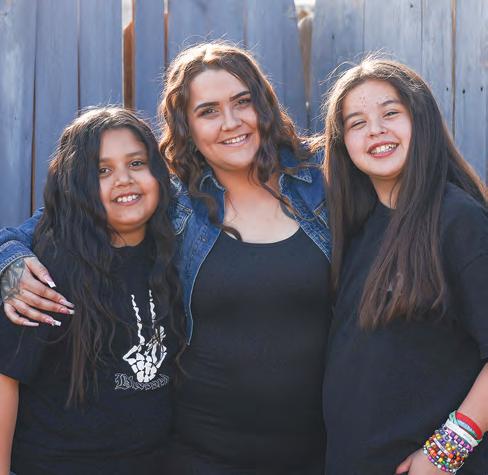
als who are experiencing a variety of social, emotional and spiritual challenges, including issues relating to substance abuse.
“For me, there was no turning back,” she said. “It’s opened my eyes a lot.”
Through the Planning for Success course, Huger said she’s benefited from hearing others’ experiences and built confidence in her communication skills through mock interview workshops.
As she works to complete her peer support specialist schooling, Huger is eagerly anticipating the future.
“There’s all kinds of opportunities,” Huger said. “I’m just putting one foot in front of the other to keep going forward to get there.”
Across state lines, The Salvation Army in San Francisco similarly emphasizes workforce development as part of The Way Out initiative. The Culinary Training Academy (CTA) provides 10-weeks of culinary training, equipping participants with the expertise needed to thrive in the food industry.
And beyond its practical education, Chef Timothy Tucker, Culinary Arts Program Director, said the program imparts

confidence and resilience in its participants, empowering them to overcome past challenges.
“Our ultimate goal is to help people find work and we do that by trying to meet them where they are,” he said.
“Chef has always been supportive of my goals and my ambitions,” said Jermaine Simpson, a graduate of the academy.
“Cooking has been a passion of mine ever since I was little and I’ve always wanted the opportunity to go to school for it, but then addiction happened.”
Simpson, like Huger and so many others, found sobriety with the help of the ARC program. Following his graduation, Simpson went on to join the first session of the CTA in San Francisco.
From there, he interned at Osito, a Michelin-starred restaurant, before finding a job as a home care professional with Homebridge.
Now he uses the culinary skills he learned to prepare meals and help people in need.
“Most of the clients are limited in the foods that they have, but that’s how I grew up, not having that much food but making a whole meal out of it, so I’m really good at doing that,” Simpson said, noting he would love to start his own business one day.
And that gets at what Tucker says is unique about workforce development programs—it’s more than just learning a skill.
“When you come through a program like ours, we’re going to help you develop a lot of different things,” Tucker added. “We’re trying to heal with wrap-around services, from housing, to life skills to financial literacy, so even though it’s a culinary program, we’re wrapping all these services around learning how to cook.” | C |
You don’t need to do anything “big” to have a big impact. The fact is, making the world work better for everyone does not require anything grandiose. And it isn’t naive. Instead, it’s about being ready. Hope is the sum total of a ton of very small motions forward. It’s the collection of choices that extend grace to make a mark—any of which YOU could make.
Here’s the key: You can make an impact for good with whatever time and skills you have. Whatever your interest, there is a you-sized need for goodness in the world.
What could happen if we each do some small something?
To help kickstart your ideas …
• Send an encouraging text: Reach out to someone you haven’t talked to in a while with a supportive message.
• Pick up litter: While you’re out for a walk, pick up any trash you see and dispose of it properly
• Share a cause’s social media post: Boost a nonprofit’s reach by sharing their content on your social media platforms.
• Pay a compliment: Brighten someone’s day by giving them a genuine compliment.
• Leave a positive review: Write a glowing review for a local business to help boost their visibility
• Help a neighbor: Offer to help a neighbor with a small task, like taking out their trash or bringing in their mail.
• Cook a meal: Prepare a simple meal for a friend, neighbor or family member who could use some support.
• Organize a mini cleanup: Gather a few friends or family members to clean up a small park or street.
• Create care packages: Assemble care packages with essential items to keep in your car or have on hand when you discover someone in need.
• Write to local leaders: Compose letters or emails to local officials advocating for change on a social issue
• Create a social media campaign: Start a 20-minute campaign to raise awareness about a cause you care about.
• Volunteer at a local food pantry: Help package, prepare or serve meals in your community
• Clean up a beach or park: Spend an hour picking up trash and debris in a local outdoor area.
• Mentor a young person: Offer an hour of guidance to a student or young professional in your field.
• Organize a clothing drive: Gather gently used clothes from friends and family for donation.
• Visit a retirement home: Spend time talking with seniors or playing games with them to brighten someone’s day.
• Participate in a blood drive: Donate blood at a local blood drive, potentially saving lives.
• Assist with disaster relief: Help pack supplies or assist with local disaster relief efforts.
• Attend a charity event: Find a fundraising event, such as a charity auction, concert or fun run to attend and support a cause
• Volunteer at a food bank: Spend a day sorting, packing or distributing food to those in need.
• Teach a skill to others: Offer a day-long workshop or class to share your expertise with a community group or school.
• Help at a local shelter: Spend time volunteering at a shelter, providing support and companionship
• Mentor youth at a summer camp: Spend the day engaging with kids at a summer camp, teaching them new skills or activities.
• Plant trees with an environmental group: Join a local environmental organization for a day of tree planting and habitat restoration.
• Assist in a disaster relief effort: Spend a day providing disaster preparation support, organizing and packing supplies or training for active response
• Lead a fundraiser for a cause: Find a local cause you care about and organize a fundraiser such as a book fair or talent show
• Volunteer at a crisis hotline: Take a shift answering calls at a crisis or support hotline, offering a voice of guidance and support.
• Create a community art project: Organize a public mural or art installation to beautify a community space | C |

This show turns wishful thinking into hopeful thinking, and hopeful thinking into action.
We’re reclaiming the meaning of “doing good,” of giving, of volunteering—of action.
Because you don’t need to do anything “big” to have a big impact.
If you’re one of the hopefuls, follow or subscribe to The Do Gooders Podcast now and let’s explore making a difference day-to-day together.
caringmagazine.org/podcast

